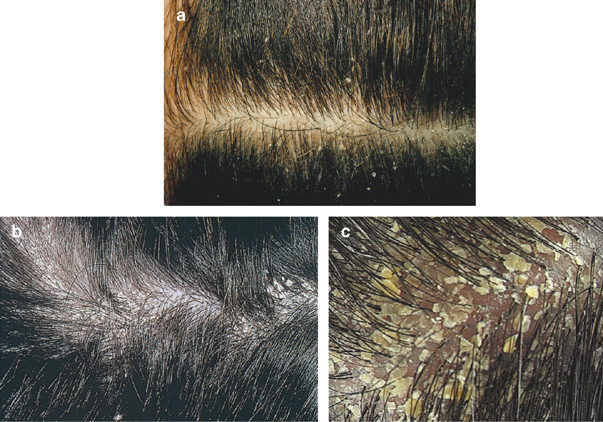
The good news is that dandruff usually can be controlled. Mild cases of dandruff may need nothing more than daily shampooing with a gentle cleanser. More stubborn cases of dandruff often respond to medicated shampoos.
Dandruff is a common chronic scalp condition marked by flaking of the skin on your scalp. Although dandruff isn’t contagious and is rarely serious, it can be embarrassing and sometimes difficult to treat.
Causes
Dandruff can have several causes, including:
- Dry skin. Simple dry skin is the most common cause of dandruff. Flakes from dry skin are generally smaller and less oily than those from other causes of dandruff, and you’ll likely have symptoms and signs of dry skin on other parts of the body, such as your legs and arms.
- Irritated, oily skin (seborrheic dermatitis). This condition, one of the most frequent causes of dandruff, is marked by red, greasy skin covered with flaky white or yellow scales. Seborrheic dermatitis may affect your scalp and other areas rich in oil glands, such as your eyebrows, the sides of your nose and the backs of your ears, your breastbone, your groin area, and sometimes your armpits.
- Not shampooing often enough. If you don’t regularly wash your hair, oils and skin cells from your scalp can build up, causing dandruff.
- Other skin conditions. People with skin conditions such as eczema — a chronic, inflammatory skin condition — or psoriasis — a skin condition marked by a rapid buildup of rough, dry, dead skin cells that form thick scales — may appear to have dandruff.
- A yeast-like fungus (malassezia). Malassezia lives on the scalps of most adults, but for some, it irritates the scalp. This can irritate your scalp and cause more skin cells to grow. The extra skin cells die and fall off, making them appear white and flaky in your hair or on your clothes. Why malassezia irritates some scalps isn’t known.
- Sensitivity to hair care products (contact dermatitis). Sometimes sensitivities to certain ingredients in hair care products or hair dyes, especially paraphenylenediamine, can cause a red, itchy, scaly scalp. Shampooing too often or using too many styling products also may irritate your scalp, causing dandruff.
Myths about acne are as common as the skin problem. One common myth is that you have to let acne run its course. Dermatologists know that letting acne runs its course is not always the best advice. Here’s why:
Treatments and drugs
Dandruff can almost always be controlled, but dandruff treatment may take patience and persistence. In general, daily cleansing with a gentle shampoo to reduce oiliness and skin cell buildup can often help mild dandruff.
When regular shampoos fail, dandruff shampoos you can buy at a drugstore may succeed. But dandruff shampoos aren’t all alike, and you may need to experiment until you find one that works for you. If you develop itching, stinging, redness or burning from any product, stop using it. If you develop an allergic reaction, such as a rash, hives or difficulty breathing, seek immediate medical attention.
Dandruff shampoos are classified according to the medication they contain:
- Zinc pyrithione shampoos (such as Head & Shoulders, Jason Dandruff Relief 2 in 1, others). These contain the antibacterial and antifungal agent zinc pyrithione, which can reduce the fungus on your scalp that can cause dandruff and seborrheic dermatitis.
- Tar-based shampoos (such as Neutrogena T/Gel). Coal tar, a byproduct of the coal manufacturing process, helps conditions such as dandruff, seborrheic dermatitis and psoriasis by slowing how quickly skin cells on your scalp die and flake off.
- Shampoos containing salicylic acid (such as Neutrogena T/Sal). These “scalp scrubs” help eliminate scale, but they may leave your scalp dry, leading to more flaking. Using a conditioner after shampooing can help relieve dryness.
- Selenium sulfide shampoos (such as Selsun Blue). These shampoos slow your skin cells from dying and may also reduce malassezia. Because they can discolor blond, gray or chemically colored hair, be sure to use them only as directed, and rinse well after shampooing.
- Ketoconazole shampoos (such as Nizoral). Ketoconazole is a broad-spectrum antifungal agent that may work when other shampoos fail. It’s available over-the-counter as well as by prescription.
Try using one of these shampoos daily or every other day until your dandruff is controlled; then cut back to two or three times a week, as needed. If one type of shampoo works for a time and then seems to lose its effectiveness, try alternating between two types of dandruff shampoos. Be sure to massage the shampoo into the scalp well and then leave the shampoo on for at least five minutes — this gives the ingredients time to work.
If you’ve shampooed faithfully for several weeks and there’s still a dusting of dandruff on your shoulders, talk to your doctor or dermatologist. You may need a prescription-strength shampoo or treatment with a steroid lotion.



